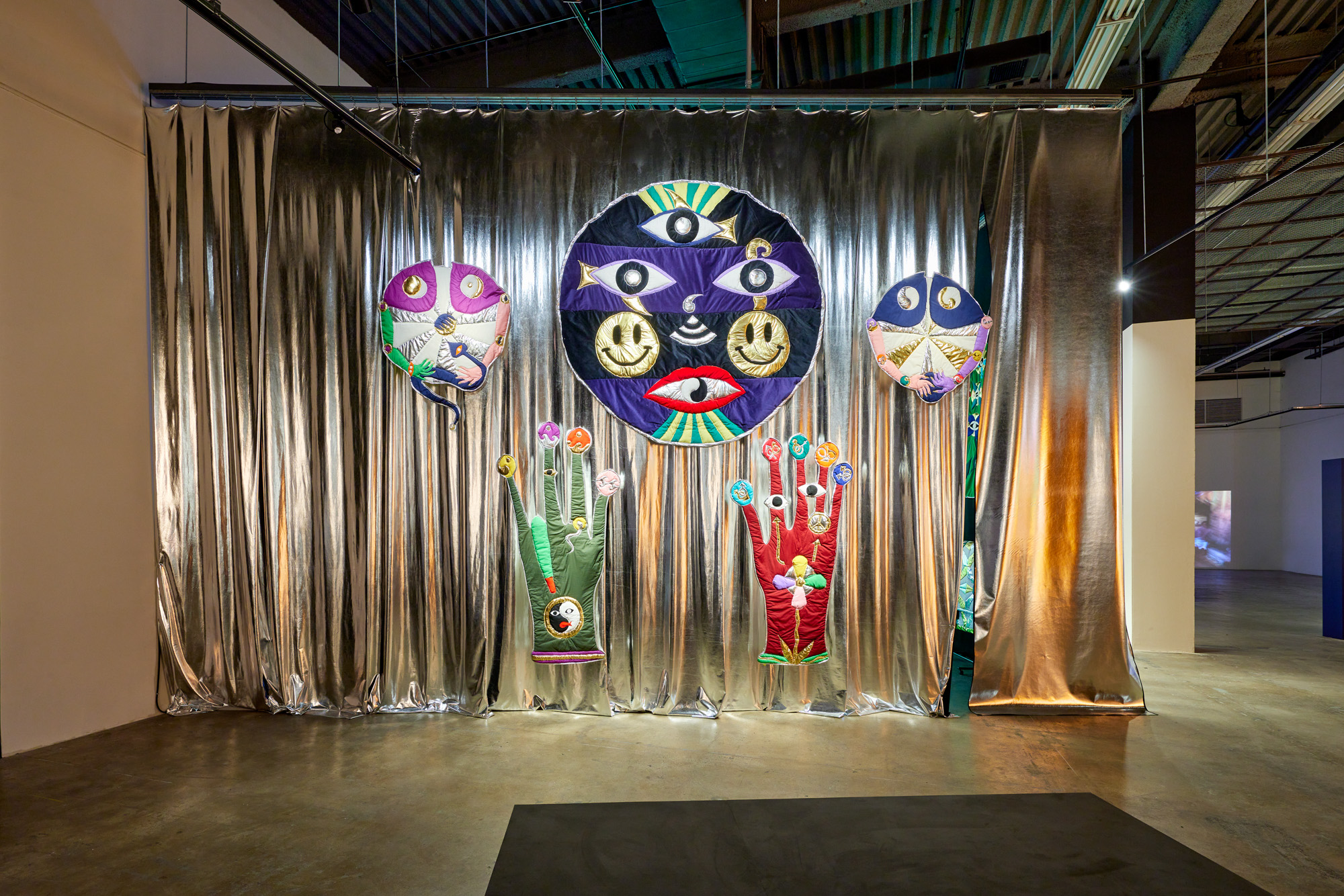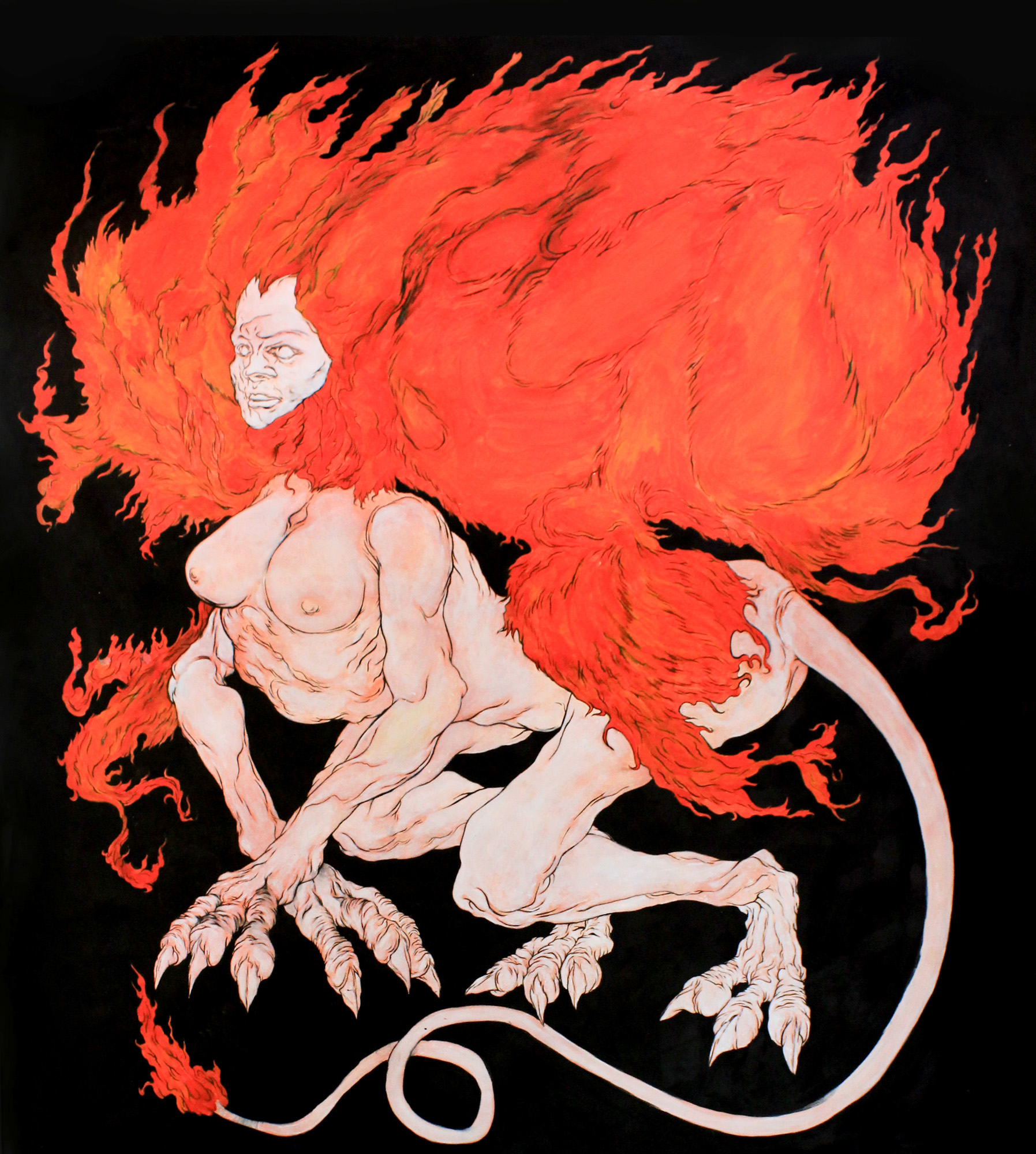13th Gwangju Biennale: “Minds Rising, Spirits Turning”
By Andy St. Louis

Installation view of ANGELO PLESSAS’s The Noospheric Society, 2021, multimedia installation, dimensions variable, at "Minds Rising, Spirits Tuning," the 13th Gwangju Biennale, 2021. Courtesy Gwangju Biennale Foundation.
The year 2020 marked a global shift in biennial scheduling, with major art festivals in Venice, Lyon, Liverpool, São Paulo, Sharjah, and Dakar all deferring their forthcoming exhibitions due to the global Covid-19 pandemic. Notwithstanding, a handful of biennial exhibitions opted to forge ahead during these trying times, most notably in South Korea, which hosted the Busan Biennale in September 2020 and the Gwangju Biennale in April 2021. While the former was a mostly straightforward affair, the latter unfolded a more diffuse presentation that necessitated assiduous unpacking of its intertwined concerns and positions. Under the artistic direction of curators Defne Ayas and Natasha Ginwala, the 13th Gwangju Biennale, “Minds Rising, Spirits Tuning,” asserted an unabashed reproval of Western, anthropocentric, patriarchal, and scientific biases that inform prevailing paradigms of knowledge production, circulation, and consumption. To this end, the exhibition’s 69 participating artists presented works that substantiated the promises of heterogeneous and collective bodies of wisdom, evoking sensibilities of solidarity and empowerment through the convergence of intellectual and ethical impulses.
Inaugurated in 1995 as a tribute to the victims of the 1980 Gwangju Uprising and the country’s subsequent democratization movement, the Gwangju Biennale serves as a platform advocating for social justice and civil resistance in the face of various forms of oppression. It is this “Spirit of Gwangju” that has informed the curatorial mandate of the Gwangju Biennale for the last quarter-century, asserting a localized imperative that has often stymied efforts to engage broader social, political, and historiographical issues in recent years. By contrast, “Minds Rising, Spirits Tuning” encompassed a vast spectrum of art practices foregrounding urgent and pertinent perspectives on critical questions faced by minority communities worldwide. Although those familiar with international currents of socially engaged practice may be habituated to the post- colonial/post-structural bent of many artists’ contributions, such viewpoints felt fresh for Korean audiences, whose purview of contemporary art is largely devoid of representation from the Global South.

SAHEJ RAHAL, from Missing Pages series, 2018-, ink, pigment and water color, and acrylic on paper, dimensions variable. Courtesy the artist; Chatterjee & Lal, Mumbai; and Museum of Art, New Delhi.
Lending conceptual structure to the biennial was a set of eight sub-themes aimed at positioning these diverse art practices within specific cognitive frameworks. Despite the perfunctory symbolism of some sections, the exhibition’s thematic groupings were adequate in spotlighting unorthodox responses to dominant belief systems and power structures that destabilize unsanctioned bodies of knowledge. In a section titled “Matters of Mutation,” for instance, works by 15 artists asserted metamorphosis and synthesis as strategies for survival in an ever-changing world, led by a number of new commissions exploring hybridity in various forms: Gözde Ilkin’s surreal fabric paintings of interspecies coexistence, As The Roots Spoke, the Cracks Deepen (2019–20), weave together a wide range of histories, cultures, and life forms; textiles and performances comprising Angelo Plessas’s installation The Noospheric Society (2021) propose “technoshamanism” as a means of remediating the disconnect between virtuality and embodied spirituality; and a video installation by Sylbee Kim, Unindebted Life (2021), envisions a future in which the absence of systemic bias yields a less stratified society that embraces pluralistic states of existence.
Subaltern voices were in ample supply throughout the exhibition, centering its discourse on alternative modes of thinking, network-building, knowledge distribution, and mass resistance that contest pervasive structures of dualism detrimental to communities on the fringes of the mainstream. For Sonia Gomes, who transforms fragments of wood and fabric into sinewy sculptural configurations, the act of binding disparate materials into vivid abstract forms mirrors her own struggle to reconcile the conflicting cultural legacies that complicate the consolidation of Afro-Brazilian identity. Such challenges were echoed in Sámi artist Outi Pieski’s suspended textile installations of colorful handwoven knots that forge links to the craft traditions and ancestral lands of her forbears, both symbols of Sámi culture threatened by Scandinavian assimilation policies.
Meanwhile, the mystical beasts and bodies that populate colorful works on paper by Sahej Rahal operate as emblems of communal empowerment by reclaiming folk iconographies that have been appropriated and misconstrued by India’s ruling elite to perpetuate casteist, patriarchal, and nationalist ideologies. Zainichi Korean artist Kwak Duck-Jun’s mixed-media abstractions invoke the struggle of diasporic communities to reconcile multiple identities, deploying plaster and shell powder to sculpt undulating surfaces covered with inscrutable symbols that blend organic and geometric imagery. And Kang Seung Lee brought to light the marginalized memories of Korea’s LGBTQ community by unveiling a reading room for the Korean Queer Archive that aims to rectify the dearth of queer representation in Korea’s official historical record.
Three satellite venues located across the city hosted additional groupings of works that resonated with site- specificity. Nestled below an old cemetery on Gwangju’s sacred Yangnim Mountain, community art space Horanggasy Artpolygon presented works that contemplate mortality in the context of communal memories, indigenous wisdoms, and heterodox mythologies Here, Green Irises (2019) and Madre Drone (2020) by Patricia Domínguez presented an array of altars enshrining video elements and objects of personal significance that demarcate spaces of mourning and healing, while Korakrit Arunanondchai’s new video, Songs for Dying (2021), connects rituals of grief and commemoration across cultures to the collective energies of civil resistance and the ebb and tide of the sea. At the Gwangju National Museum, a public institution charged with collecting, preserving, and interpreting artifacts from Gwangju and the surrounding region, Theo Eshetu implicates dehumanizing postcolonial museological rhetorics in the video Ghostdance (2020), conflating Asian and African bodies with ethnographic specimens destined for display. Similar polemics surrounding the rights of the dead inform Gala Porras-Kim’s provocative installation A terminal escape from the place that binds us (2020), which juxtaposes actual human remains from the museum’s collection and abstract ink paintings created through a process of summoning the spirits of the dead to visually manifest their preferred resting place.

Installation view of PATRICIA DOMINGUEZ’s Green Irises, 2019, multichannel video installation with altars, totemic figures, watercolors, flowers, objects, and holographic projections, dimensions variable, at "Minds Rising, Spirits Tuning," the 13th Gwangju Biennale, 2021. Photo by Sang Tae Kim. Courtesy Gwangju Biennale Foundation.
Alongside the works on view at the Gwangju National Museum and the main Exhibition Hall were images and objects on loan from the Museum of Shamanism and Gahoe Minhwa Museum, private entities located in Seoul that specialize in shamanic relics and folk paintings, respectively. Aside from a single instance in which multiple images of female deities were presented in a concise grouping, these pieces were interspersed throughout the galleries and isolated from one another; bereft of context and stripped of their agency as visual conduits to the spirit realm, they evinced little relevance to the surrounding contemporary artworks or the specific sub-theme to which they pertained. Regrettably, the scattershot inclusion of these pieces did not meaningfully contribute to the discursive latitude of the biennial. Instead, they became tokenized in a clumsy attempt to ground the exhibition’s central premise amid the milieu of Korea’s complex folk religion traditions.
Reflecting this well- intentioned oversight was the biennial’s pronounced emphasis on inclusivity, championing an abundance of interpretations of the so-called “extended mind” that diluted the exigency of its constituent thematic threads. Indeed, by deliberately casting a wide curatorial net, “Minds Rising, Spirits Tuning” fell victim to its own magnanimity and prioritized an overly passive approach to moderating the diverse perspectives assembled here. To be sure, the biennial’s superlative meeting of minds generated exceptional potential for sparking meaningful conversations regarding expanded notions of intelligence; however, when individual voices are drowned out by the din of everyone speaking at once, the ensuing cacophony only results in listeners tuning out rather than tuning in.







